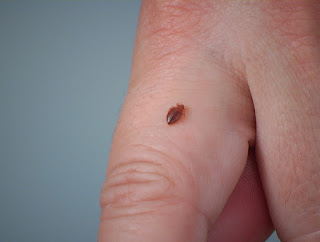Chigger identification
Chiggers, or harvest mites are microscopic, reddish arachnids that usually cannot be seen with the naked eye. The larvae (babies) hatch in grass and foliage and attach themselves to anyone who gets close enough for them to climb onto. After finding a suitable host, the larvae attaches itself to a pore or hair follicle and injects digestive enzymes into the hole that promptly dissolve the surrounding skin cells which are then used for nourishment by the growing chigger. Once they've eaten their fill they release from their hosts, grow into adults and feed on plant matter on which they lay more eggs.The bites themselves usually progress into super-itchy, raised red welts that can take up to two weeks to heal. Below you will find instructions for eliminating chiggers as well as reducing the effects of their bites.
Eliminating chiggers from your property
Chiggers are active during the warm season from spring to early fall. They can be found living in berry patches and bushes, tall grass and weeds, straw, leaves, fences, bark, and dense foliage.Shelter and breeding grounds
Outside, keep grass trimmed and weeds pulled. Remove any dense foliage that isn't part of the landscaping as well as piles of decaying leaves and plant matter. Flood all remaining foliage with a mixture of soap and water to kill off adults and larvae. Repeat the flood once a week for a month to get newly hatched larvae and you should have eliminated most of them.
If they've made it into your houseplants, move them outdoors and kill the adults and larvae by soaking them with a mild insecticidal soap that is labeled as safe for edibles or houseplants. Keep the plants away from people and pets and repeat the rinse weekly for four weeks.
Chigger treatment and prevention
If a person or pet becomes infested with chiggers, it's important that you wash them as well as their clothing at the same time. Otherwise larvae that hadn't yet made it to the skin can stick around for another chance and once they feed, they will drop off and head for the nearest houseplant.Repellents
When traversing a potentially infested area, try not to move through dense foliage or sit on the ground. Following are some additional preventative measures:
Protective clothing
The most protective clothing you can wear is tight-knit, loosely fitting garments that leave no exposed skin for a chigger to latch onto. Wear your shirt and socks over your pants along with shoes that do not have open ventilation holes. Bathe and wash all of your clothes on the hottest setting with detergent immediately upon returning.
Sulfur powders
Sulfur powders available at your local drug store work well as a chigger repellent. Apply in and on your clothing and shoes before heading out. A powder puff makes application much easier.
Insect repellents
Insect repellents containing DEET (Diethyl-m-toluamide) are effective at repelling chiggers. Apply these to your clothing, not to your skin or to your pets. Be sure to use on your shoes, pant legs, waist, shirt and sleeves.
Citronella oil based products
Citronella oil is derived from citronella grass. It is used in perfumes, soaps, and insect repelling sprays, candles and tiki torches. These are marketed mainly as mosquito repellent but also repel chiggers.
Chigger removal
If you think you've just become host to a gang of chiggers, immediately wash all of your clothing with detergent and on the hottest setting - then wash yourself with plenty of soap and hot water. An exfoliating pad can be used and special attention should be paid to warm, moist areas (inside of knees, groin, anus, waist, armpits, neck, between toes, etc).
Chigger bites
Chigger bites are insanely itchy and swell into raised red welts that can last for a couple of weeks before subsiding. As difficult as it may be, resist scratching these bites - they can become infected. Instead, apply something that will limit their exposure to air. Several possibilities that people have reported success with are:
- Clear nail polish
- Green tea extract
- Calamine lotion
- Hydrocortisone cream
Tags :
Pests And Diseases
Subscribe by Email
Follow Updates Articles from This Blog via Email


No Comments